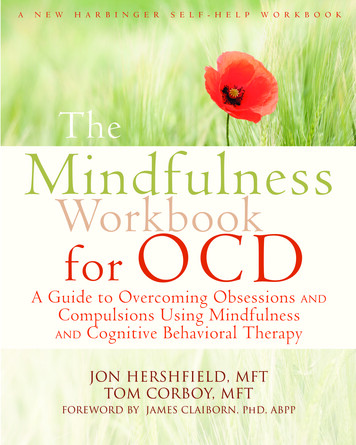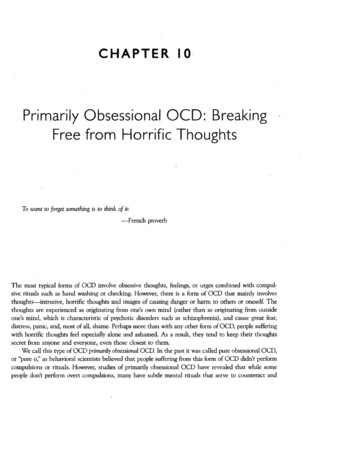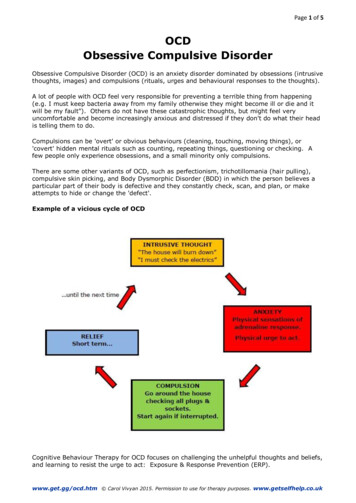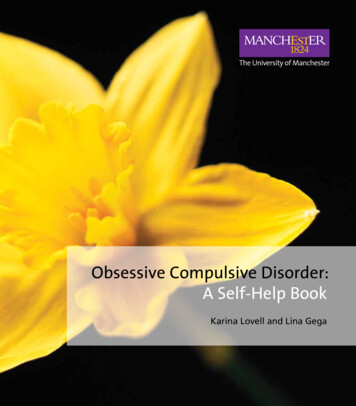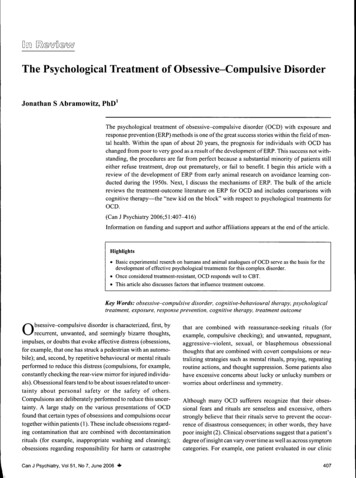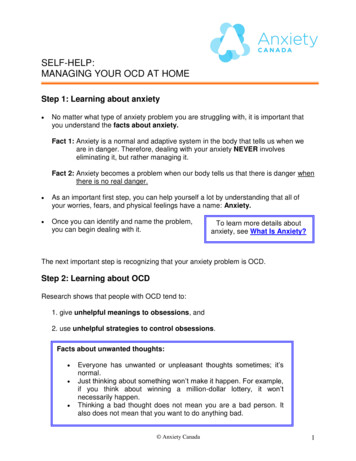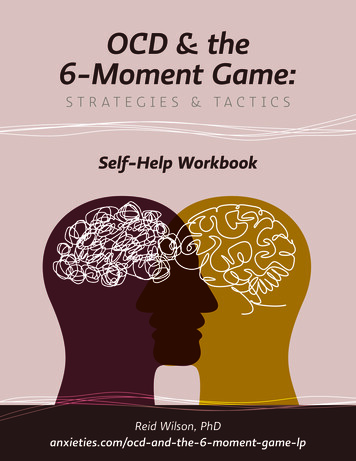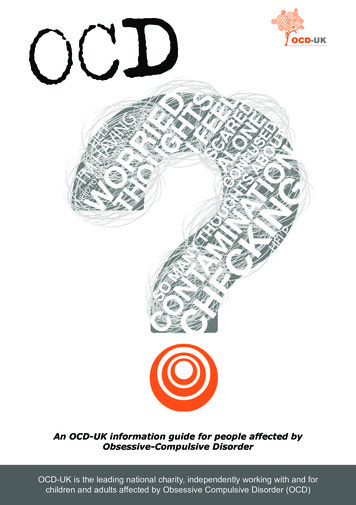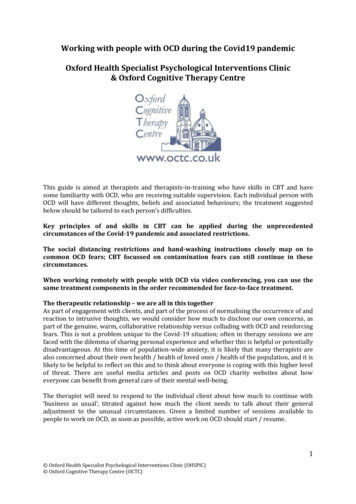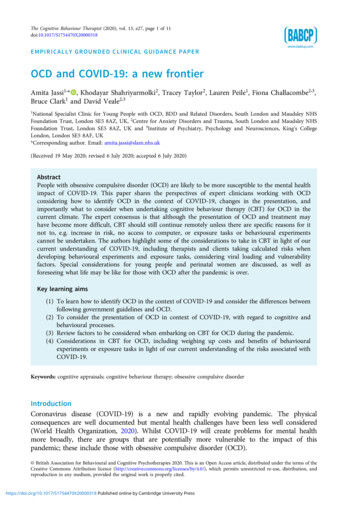
Transcription
The Cognitive Behaviour Therapist (2020), vol. 13, e27, page 1 of 11doi:10.1017/S1754470X20000318EMPIRICALLY GROUNDED CLINICAL GUIDANCE PAPEROCD and COVID-19: a new frontierAmita Jassi1,* , Khodayar Shahriyarmolki2, Tracey Taylor2, Lauren Peile1, Fiona Challacombe2,3,Bruce Clark1 and David Veale2,31National Specialist Clinic for Young People with OCD, BDD and Related Disorders, South London and Maudsley NHSFoundation Trust, London SE5 8AZ, UK, 2Centre for Anxiety Disorders and Trauma, South London and Maudsley NHSFoundation Trust, London SE5 8AZ, UK and 3Institute of Psychiatry, Psychology and Neurosciences, King’s CollegeLondon, London SE5 8AF, UK*Corresponding author. Email: amita.jassi@slam.nhs.uk(Received 19 May 2020; revised 6 July 2020; accepted 6 July 2020)AbstractPeople with obsessive compulsive disorder (OCD) are likely to be more susceptible to the mental healthimpact of COVID-19. This paper shares the perspectives of expert clinicians working with OCDconsidering how to identify OCD in the context of COVID-19, changes in the presentation, andimportantly what to consider when undertaking cognitive behaviour therapy (CBT) for OCD in thecurrent climate. The expert consensus is that although the presentation of OCD and treatment mayhave become more difficult, CBT should still continue remotely unless there are specific reasons for itnot to, e.g. increase in risk, no access to computer, or exposure tasks or behavioural experimentscannot be undertaken. The authors highlight some of the considerations to take in CBT in light of ourcurrent understanding of COVID-19, including therapists and clients taking calculated risks whendeveloping behavioural experiments and exposure tasks, considering viral loading and vulnerabilityfactors. Special considerations for young people and perinatal women are discussed, as well asforeseeing what life may be like for those with OCD after the pandemic is over.Key learning aims(1) To learn how to identify OCD in the context of COVID-19 and consider the differences betweenfollowing government guidelines and OCD.(2) To consider the presentation of OCD in context of COVID-19, with regard to cognitive andbehavioural processes.(3) Review factors to be considered when embarking on CBT for OCD during the pandemic.(4) Considerations in CBT for OCD, including weighing up costs and benefits of behaviouralexperiments or exposure tasks in light of our current understanding of the risks associated withCOVID-19.Keywords: cognitive appraisals; cognitive behaviour therapy; obsessive compulsive disorderIntroductionCoronavirus disease (COVID-19) is a new and rapidly evolving pandemic. The physicalconsequences are well documented but mental health challenges have been less well considered(World Health Organization, 2020). Whilst COVID-19 will create problems for mental healthmore broadly, there are groups that are potentially more vulnerable to the impact of thispandemic; these include those with obsessive compulsive disorder (OCD). British Association for Behavioural and Cognitive Psychotherapies 2020. This is an Open Access article, distributed under the terms of theCreative Commons Attribution licence (http://creativecommons.org/licenses/by/4.0/), which permits unrestricted re-use, distribution, andreproduction in any medium, provided the original work is properly cited.https://doi.org/10.1017/S1754470X20000318 Published online by Cambridge University Press
2Amita Jassi et al.Table 1. Potential differences between COVID-19 government guidelines and OCDCovid-19 government guidelinesOCDWash hands or use hand gel for 20 secondsWash hands or use hand gel until ‘internal referenced’criterion has been satisfied, likely to be more than 20 secondsWash hands or use hand gel in response to an obsession,idiosyncratic trigger or pre-occupation/obsession regardingCOVID-19 (likely to be frequent and excessive)Wash hands or use hand gel in a rigid and ritualised wayWash hands or use hand gel whenreturning home from public placeWash hands or use hand gel generallyfollowing steps advised by governmentAvoid touching things others may havetouched – use sanitiserDo not allow anyone outside familyin homeSocial distanceWear gloves at all times, even at homeDo not allow anyone in the homeStop going out altogetherThis paper walks through the main clinical considerations when working with OCD in thecontext of COVID-19, including what to consider in the delivery of cognitive behaviourtherapy (CBT). It is written by clinicians working with young people and adults across bothin-patient and out-patient national specialist OCD services in the UK. It offers practicaladvice and clinical reflections, including case examples, to support others working with thisclient group.Identifying OCD in the context of COVID-19OCD is a common disorder affecting around 1.6% of adults (Kessler et al., 2005) and 1–3%of children and adolescents (Heyman et al., 2001; Valleni-Basile et al., 1995). OCD can centreon recurrent or persistent obsessions or pre-occupation around a fear of contracting/sufferingfrom an illness or fear of contamination, which drives sufferers to engage in repetitive behavioursor avoidance to reduce the risk of developing the illness. Obsessions/pre-occupation orcompulsions/behaviours in these disorders are time consuming (e.g. take more than 1 hour perday) and cause clinically significant distress or impairment in social, occupational or otherimportant areas of functioning (American Psychiatric Association, 2013; World HealthOrganization, 2019).Stringent following of UK government guidelines to reduce the risk of contracting COVID-19to an observer may mimic the presentation of some of the most publicly perceived symptomsof OCD, for example repetitive handwashing/antibacterial gel use, avoidance of potentialcontaminants, or socially isolating. An understandable consequence of COVID-19 is heightenedanxiety due to the increased likelihood and awfulness of the threat. However, it is important toconsider what the differences are between those who are following government guidelines tothose with OCD to inform clinical practice. These centre on a different set of beliefs andmotivations driving the behaviours, and their cessation (see Table 1).People without OCD are more likely to follow the guidelines in the way set out by thegovernment (i.e. thorough handwashing for 20 seconds), whereas those with OCD may belikely to wash until meeting an ‘internally referenced criterion’ such as ‘feeling comfortable’ or‘just right’, resulting in prolonged and repetitive behaviour that is likely to be longer than20 seconds. They may wash their hands more frequently than those who are followingCOVID-19 guidance and may do so in response to an obsession (i.e. intrusive thought,doubt or sensation), an idiosyncratic trigger (e.g. after a shower) or in response to the preoccupation with or fear that they may be at risk of contracting COVID-19, rather than a timewhen they may need to, such as coming home from a public place. It is likely that suffererswill clean or hand wash in a rigid or ritualised way. They may have developed methods forhttps://doi.org/10.1017/S1754470X20000318 Published online by Cambridge University Press
The Cognitive Behaviour Therapist3Box 1. Case example of OCD in context of COVID-19A 39-year-old married man was fearful of himself and his family catching COVID-19. His children had beenkept in the house for the previous 6 weeks during ‘lockdown’. He reported that parcels delivered to hishome were kept in quarantine in the garden for 3 days. The garden patio would be washed down withboiled water and Dettol. All non-perishable food is sterilised by boiling in water before it can be eaten.He went out for the odd run but kept a 5 metre distance. He sprayed his door handles and bell daily withalcohol. He avoided touching taps, window locks and door handles in the house. He washed his handsabout 20 times a day. His wife had to accommodate his anxiety-driven behaviours.cleaning shopping with anti-bacterial gel, or quarantining parcels and shopping delivered for a setperiod of time before they can be opened. These behaviours are clearly idiosyncratic, excessive andnot recommended by government guidelines. In addition to this, people with OCD may report aheightened moral responsibility for spreading COVID-19 and may engage in other behaviourssuch as excessive checking of COVID-19-related information and reassurance seeking. Finally,there may also be repeated consultation with medical professionals or advice lines, withoutlasting reassurance. The next section will consider in more detail the presentation of OCD inthe context of COVID-19.It is likely that as the current pandemic took hold and awareness increased, most individualswithout OCD will have experienced some increased distress and safety-seeking behaviours. Theseunderstandable, ego-syntonic responses to an objective increase in threat should not bepathologised and, as time has passed, most of these behaviours will have reduced. Cliniciansshould, however, be alert for those who may start to exceed the diagnostic threshold for OCD,whose obsessions and compulsions are becoming excessive, time consuming, distressing andinterfering with their lives (see Box 1 for an example). There is no evidence to suggestincreased rates of OCD during or immediately after other major health scares, such as HIV,swine flu, etc. Nevertheless, if people do start to exhibit more enduring symptoms in line withOCD, this may warrant a referral for CBT (see ‘What to consider in CBT’ section below).OCD presentation during COVID-19Presentations of OCD can be very idiosyncratic; some people may be relatively unscathed by thecurrent virus, others may experience elevated and devastating degrees of distress. Some have evendescribed that the societal restrictions in place to manage COVID-19 have led to perceived shortterm benefits. For example, the ‘lockdown’ may facilitate some compulsive behaviours, such asreassurance seeking (e.g. by ensuring that household members are close by at all times) andavoidance (e.g. by reducing contact with children for those with paedophilic obsessions). Somehave stated other ‘positive’ aspects such as a perceived validation of beliefs about theharmfulness of contamination, and relief and reassurance in government-mandated hygienepractices and safe distancing. Lockdown may also be preferred as it allows one to avoid theuncertainty of appropriate levels of precaution-taking.Some sufferers have reported that the content of obsessions/pre-occupations has changedsince the pandemic; those with other contamination/illness concerns are now more focused onCOVID-19. Others have reported a worsening of their symptoms, which may be due to manydirect and indirect factors related to COVID-19. Without doubt there is an increase in threat/risk and information about that threat; OCD sufferers are likely to have attentional biasestowards threat information.Furthermore, there is a surfeit of information from multiple sources which is rolling andinstant in the digital age (Freeston et al., in press). Unfiltered information may be 18 Published online by Cambridge University Press
4Amita Jassi et al.Box 2. Case example of inflated responsibilityA young autistic woman aged 17 became distressed when her mother developed moderate symptoms ofCOVID-19, necessitating brief hospitalisation. She became pre-occupied with the thought that she hadinfected her mother (without objective evidence of this) and driven to carry out increasingly timeconsuming rituals. In addition to excessive handwashing, cleaning of objects, avoidance of anythingassociated with her mother and frequent reassurance seeking, she also spent hours each day praying.These behaviours had been present to varying degrees previously but had responded well to CBT, sothis marked a sudden deterioration. She expressed a belief that not carrying out compulsions wouldlead to her mother’s death and this would be entirely her fault.contradictory, untrustworthy or even misinformation. The 24-hour news cycle and widelyaccessible information online about COVID-19 can exacerbate checking behaviours andreassurance seeking. The constant checking of information will undoubtedly create furtherfear and uncertainity. A worsening of symptoms can occur as people engage in a cycle oftriggered excessive threat perception, anxiety and excessive compulsions, such as showeringfor hours after arrivals of post and food shopping, handling everything with gloves andwiping every item down. Some have reported that despite taking recommended precautions,they still ‘feel’ that COVID-19 has contaminated their homes and they experience urges todecontaminate it entirely, even to an extreme of removing wallpaper and flooring.Intolerance of uncertainty (IOU) is a well-documented feature of OCD (Tolin et al., 2003;Boelen and Carleton, 2012). Various sources of uncertainty to do with the pandemic may berelevant to people with OCD. Uncertainty around whether individuals have COVID-19 ornot, about the ‘right’ level of necessary precaution, receiving inconsistent or even conflictingmessages from different institutions, as well as ‘the new normal’, where even people withoutOCD are trying to avoid potential contamination in a variety of ways, may make sufferersuncertain about whether they are taking the right approach or whether what they are doing isexcessive. Additionally, with the government guidelines around washing and social distancing,some OCD sufferers are reporting difficulty in identifying which behaviours are acceptableand recommended versus what is driven by their anxiety. IOU may mainfest in a variety ofresponses, including repeated researching and analysing of information related to the virusand precautionary measures, reviewing whether one has carried out actions properly, oraltogether avoiding tasks where the associated uncertainty is deemed unacceptably high.Inflated responsibility, the belief ‘that one has power that is pivotal to bring about or preventsubjectively crucial negative outcomes’ which therefore obliges action (Salkovskis et al., 1995),is another key concept in cognitive models of OCD. When faced with the uncertaintyassociated with COVID-19, those with OCD may feel driven to take what they perceive asresponsible action, with no upper limit to this definition. Responsibility beliefs may encompassperceptions of others as insufficiently careful, and therefore drive attempts to compensate for thisby taking excessive actions to prevent harm to self or others, including checking that others havefollowed routines properly. For sufferers who are parents, this may extend to imposing excessive(and potentially harmful) routines on children, which may need to be factored into riskassessment. A case example of inflated responsibility is presented in Box 2.Individual patterns of safety-seeking behaviour and avoidance will be meaningfully linked tocognitive themes. Those with IOU appraisals may seek absolute certainty that they have takenproper precautions, leading to repetitive actions. They may adopt subjective terminationcriteria for when to stop handwashing, such as feeling ‘just right’, timing or otherwise closelymonitoring actions. Decision-making about how to behave may be impacted by conflictingmessages about the correct levels of precaution, with the highest levels sought and adhered to.https://doi.org/10.1017/S1754470X20000318 Published online by Cambridge University Press
The Cognitive Behaviour Therapist5Attempts to remove contamination may become extreme, perhaps involving use of specialisedproducts, repeated cleaning, etc. Those whose main fear is that they will spread the virus toothers might engage in repeated checking (e.g. self-monitoring for possible symptoms,mentally retracing their steps and reviewing who may have had contact with), andreassurance-seeking/confessing. Extreme levels of agoraphobic avoidance may be seen as theonly way to achieve certainty about one’s likelihood of causing harm and/or having actedresponsibly. In summary, while the content of this threat is new, the mechanisms of responsewithin OCD remain consistent with other well-documented stimuli.Finally, the circumstances of lockdown including severe disruption of routine, financial andinterpersonal stress and limited access to external protective factors, may lead to a vacuumthat OCD can fill. Disruptions to routine and activity can contribute to low mood, which inturn increases the accessibility of intrusive thoughts and reinforces their credibility. Anadditional consequence of lockdown is the impact on families and partners, who arerelentlessly exposed to their loved one’s difficulties and may have to accommodate symptomsto a greater degree, e.g. giving reassurance, changing routines and cleaning items on behalf ofthe sufferer. This is likely to increase anxiety, tension and conflict in the home environment.The changes in presentation and processes described above are important to consider informulation and treatment (see ‘What to consider in CBT’ section below).CBT or not CBT? That is the questionCBT is the recommended and evidence-based psychological treatment for adults and childrenwith OCD (National Institute for Health and Clinical Excellence, 2005). During the lockdown,services may offer treatment remotely via video-conferencing and telephone. Studies haveshown this is a viable treatment option for many, and outcomes are equivalent to face-to-faceCBT (e.g. Wootton, 2016). It is important to consider a range of factors before embarking onthis work.There are practical considerations such as whether someone can access remote treatment,e.g. availability of personal computers or devices, use of a quiet and confidential space forsessions and access to session materials. Clinicians have noted some advantages of remoteCBT, for example people using their telephones in sessions and the ability for them to movearound in areas where their OCD is triggered, making the work more ecologically valid. Somegroups may struggle with remote CBT, such as young people with autism spectrum disorder(ASD) or attention deficit hyperactivity disorder (ADHD). In such cases, some services areoffering face-to-face treatment in clinic with service users and therapists both wearingpersonal protective equipment (PPE) such as masks. PPE may impact on rapport building orundermine some in-session work, e.g. coming into contact with contaminants. Additionally,there may be travel restrictions such as not being able to use public transport, which maymake accessing CBT in clinic difficult. Overall, the pros and cons of the mode of delivery(remote vs in clinic) need to be discussed with the client before deciding which approach to take.Given the context of likely heightening of general anxiety and uncertainty, a discussion with theclient is needed about whether they feel able to commit to therapy and try to overcome theirdifficulties in the context of COVID-19. It is important to consider whether commencingCBT in the current climate has the potential to increase risk (e.g. self-harm), and if so,whether a risk management plan can effectively be put in place in current circumstances, sothat the individual has access to the support they need (Veale et al., 2009). Clinicians needalso to consider whether government guidelines will restrict the feasibility of undertakingspecific behavioural experiments or exposure tasks, without which treatment would besubstandard. For example, a client with olfactory reference disorder needed to be able to beclose to strangers in busy areas to test out their fears that others will be disgusted by theirhttps://doi.org/10.1017/S1754470X20000318 Published online by Cambridge University Press
6Amita Jassi et al.perceived smell, which is not possible to do with social distancing government guidelines, and assuch treatment therefore was put on hold.Where it is agreed that it is not the time to embark on CBT, individuals may benefit fromaccessing support through regular clinician contact to review and monitor how they aremanaging. Having said this, in our experience, the majority of people are managing to engagein CBT at this time.What to consider in CBTAt present there are no empirical data on the cognitive processes and behaviours that mayunderlie COVID-19-related OCD. Future research may reveal similarities and differences inthese factors; however, our impression is that the processes are the same. Based on our earlyclinical observations, there are likely to be several key cognitive factors to consider in CBT.People with OCD who are high in IOU will struggle to tolerate the uncertainty associatedwith COVID-19, which may include not knowing whether surfaces, other people, etc. may becontaminated; whether one may have the disease oneself (and be contagious); what theappropriate level of precaution is to be taking; or whether one may have unknowingly spreadthe virus to others. An inflated level of responsibility for harm, where one has an exaggeratedperception of one’s degree of influence over feared outcomes, will motivate excessive attemptsto prevent harm. Beliefs about others (e.g. members of the public) being insufficiently carefulmay in turn contribute to the perception that one has to take an even greater level ofprecaution to compensate for others’ negligence. Closely related to inflated responsibility isthe concept of ‘agency’, which is the belief that having an intrusion makes one responsible forthe outcome by just having the thought (e.g. ‘having a thought about someone contractingCOVID-19 makes me responsible for preventing it’). OCD sufferers’ perceptions of risk arealso likely to be over-estimations and characterised by ‘all-or-nothing’ thinking, for exampleperceiving relatively low-risk situations (e.g. walking outside while observing social distancingguidelines) as equivalently risky to high-risk scenarios.There are other manifestations of OCD where the nature of the fears are more qualitativelydistinct from those of non-OCD sufferers, but where the content has now become focused onCOVID-19. These include, for example, ‘thought–event fusion’ or magical thinking, wherethere is a fear that one has the power to cause COVID-19-related harm just by thinking aboutit (e.g. ‘if I picture a loved one contracting the virus, I will make it happen’), or ‘foretelling’,where the belief is that having an intrusion about COVID-19 represents an omen and meansthat it will happen in the future. Fears of ‘transfer’ may take the form of believing that havingan intrusion about COVID-19 can transfer properties onto another object or person, by justhaving the thought (e.g. ‘if I think my hands are contaminated, then I can transfer thecontamination onto objects through my thoughts’).Treatment should begin with the development of an individualised formulation, whichhighlights the idiosyncratic cognitive processes and behaviours. As part of this, introducingan alternative perspective (Theory A/B) and highlighting this as a problem of excessivepre-occupations and concern about COVID-19 is important. It is likely to be important atthis stage to discuss what is deemed excessive, i.e. going beyond government guidelines,significant impact on functioning, increase in distress. For clients whose OCD predated thepandemic (perhaps sub-clinically), it could be useful to consider with them whether thecognitive themes and patterns of responding may be the same. Cognitive interventionsare likely to include normalisation of the uncertainty surrounding the virus and the correctlevels of precaution. IOU can be introduced as a concept with reference to various metaphors,with the message that individuals in the general population will vary in their ability to toleratethe uncertainty inherent in the virus. An implication for treatment will therefore be to helphttps://doi.org/10.1017/S1754470X20000318 Published online by Cambridge University Press
The Cognitive Behaviour Therapist7increase one’s tolerance of the uncertainty. Responsibility beliefs can be evaluated using thestandard methods. These include continua methods to show that responsibly behaviour inrelation to the virus is not all-or-nothing but on a spectrum; adopting maximum levels ofresponsibility has unintended costs and reducing one’s level of responsibility does not equatewith becoming negligent. Responsibility pie charts may be useful for clients whose attributionsfor preventing harm are excessively focused on themselves. Cost–benefit analyses willinvariably form part of these conversations, drawing attention to the unintended consequencesof continuing with the existing strategy. All-or-nothing styles can be addressed throughcontinua methods and guiding the client to consider the grey area and sharing with them thatwe are living in this area together.Behavioural interventions should be set up to test an emerging, alternative cognitive account ofthe problem (Theory B) as one of excessive worry and pre-occupation about COVID-19. Processessuch as IOU, excessive responsibility, all-or-nothing thinking and over-estimation of risk mayalso be targeted in behavioural tasks. The underlying principles of behavioural interventionsin this context will therefore be to carry out exposure to uncertainty/perceived responsibilityfor harm, within the bounds of the current context. The aims are to develop tolerance ofuncertainty and widen the bandwidth of behaviour in line with a more functional level ofresponsibility.On the surface, behavioural tasks usually associated with the treatment of OCD may appear tobe contraindicated by public health advice and common-sense precaution-taking. Whencollaboratively developing tasks with clients, it is important to tailor tasks considering newemerging evidence about COVID-19, including information on viral loading and vulnerabilitygroups (e.g. elderly, ethnic minorities, pregnant women). Considering environments wherethere may be low viral loading (e.g. open outdoor spaces) and working up to higher viralloading environments (e.g. small indoor spaces) can be one way to increase the difficulty oftasks. Most people are in the low vulnerability group, therefore tasks collaboratively developedwith the client should include higher risk, e.g. go outside for a walk, touch a handrail and nothandwash when they get home. If working with someone in a vulnerable group, tasksmay need to be tailored to consider this, e.g. go outside for a walk, touch handrail and do a20 second handwash when they get home.As therapists we help our clients to weigh up their choices and to help them to choose to beginto bravely take risks which are either not present in reality or are exaggerated. This may be a moreanxiety-provoking time for therapists too, as we work out our new limits in doing behaviouralexperiments or exposure tasks; we will have to be safe and within ethical codes, whilst alsoenabling our clients to take the necessary ‘risks’ to overcome their OCD. Each task wouldneed to be developed considering the cost–benefit of task, calculating the risk (viral loadingplus vulnerability factors) against the potential benefit of challenging the OCD.Specific exposure tasks will be guided by personalised therapy goals that are meaningful to theclient and enable them to live as functionally as possible during the crisis. Tasks may thereforeinclude activities that are outside the client’s current bandwidth but which many people withoutOCD are still willing to engage in.Special groupsYoung peopleThere is growing awareness of the potential emotional and developmental impact of COVID-19restrictions on children and young people (e.g. Lee, 2020), with substantial changes to their dailystructure, environments and learning opportunities. For young people with neurodevelopmentalconditions such as ASD (where predictability and routine may be key to emotional coping),ADHD (who are often reliant on regulation from physical activity) or where parentinghttps://doi.org/10.1017/S1754470X20000318 Published online by Cambridge University Press
8Amita Jassi et al.capacity is reduced by other difficulties within the family, this impact may be increased. It isthrough this lens that formulation and interventions for young people experiencing OCD inthe context of COVID-19 should be understood. Although some provision remains in placefor vulnerable children and young people, many parents have reduced access to support andrespite. This unfortunately has the potential for spiralling distress and family burn-out.Therapists should consider whether CBT-informed work with parents to contain and reducetheir accommodation of OCD symptoms, for example, may have greater benefits in suchsituations than individual CBT.As with adults, there are many young people who are able to make use of remote CBT for OCD(Lenhard et al., 2017; Turner et al., 2014). For those already familiar with online communication,the switch to this way of working may prove a smoother transition than for their adultcounterparts or indeed therapists. The age and developmental profile of a young person, theavailability of a quiet and calm space (alongside a parent if appropriate) in which to conducttherapy sessions, the ability to tolerate sustained screen time in a focused way and theopportunities for meaningful exposure will all influence the decision to undertake CBT.For a young person out of school, with no direct contact with peers or indeed no time spentindependently from their parents, some ingenuity may be required to identify exposure tasks thattap into the individual’s core OCD fears. This may be the time to adopt creative imagery-basedtasks, to recruit grandparents and friends as online ‘stooges’ or to exploit the growing number ofplatforms available for exploring virtual worlds. Helpful modifications to sessions may include theuse of sensory objects
EMPIRICALLY GROUNDED CLINICAL GUIDANCE PAPER OCD and COVID-19: a new frontier Amita Jassi 1,* , Khodayar Shahriyarmolki 2, Tracey Taylor , Lauren Peile , Fiona Challacombe2,3, Bruce Clark1 and David Veale2,3 1National Specialist Clinic for Young People with OCD, BDD and Related Disorders, South London and Maudsley NHS Foundation Trust, London SE5 8AZ, UK, 2Centre for Anxiety Disorders and .
